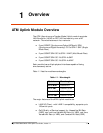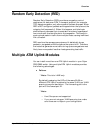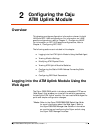
Cajun P550/P880 Switch ATM Uplink User Guide, Version 1.1
Overview
1-3
■
LECS
(LAN Emulation Configuration Server) - An entity
that assigns individual LANE clients to particular Emulated
LANs (ELANs) by directing them to the LAN Emulation
Server (LES) that corresponds to the ELAN. There is logically
one LECS per administrative domain, and this serves all
ELANs within that domain.
■
LES
(LAN Emulation Server) - An entity that implements
the control function for a particular ELAN. There is only one
logical LES per ELAN, and it is identified by a unique AT
address.
■
BUS
(Broadcast and Unknown Server) - Multicast server
used in ELANs to flood traffic addressed to an unknown
destination and to forward multicast and broadcast traffic to
the appropriate clients.
The basic concepts are consistent between LANE V1 and LANE V2,
however there are some differences between them. The main
difference is that LANE V2 provides QoS support and multiplexing
of Virtual Circuits (VCs).
LANE is one of the mechanism the ATM Uplink module uses to
simulate a LAN over the ATM network. By implementing a LANE
client in the ATM Uplink module, the ATM network can seamlessly
provide connectionless LAN and multicast capabilities to the rest of
the Cajun system.
The logical topology of the ATM Uplink module interfaces is quite
different from the physical connections. LECs are configured on the
ATM Uplink module. A LEC is not associated with a physical port,
but instead is associated with a LANE server that forms an ELAN.
A LEC is treated similarly to an Ethernet port of the Cajun system
and is associated with a Virtual LAN (VLAN). A LEC is represented
and configured as a switch port in the Cajun system. Each VLAN
may have only one LEC per ATM Uplink module, and each module
may have only one LEC per ELAN.


















